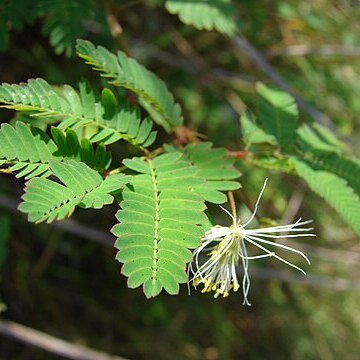Subshrubs [or trees, shrubs, or perennial herbs]. Leaves bipinnate; stipules persistent, setaceous; pinnae [1-]2-6[-15] pairs; leaflets small; petiolar gland often between lower pair. Heads solitary, axillary, ovoid-globose. Flowers all bisexual, or lower male or neuter and sometimes without petals but with short staminodes. Calyx campanulate, shortly dentate. Petals free or nearly so. Stamens [5 or]10, free, exserted; anthers eglandular at apex. Ovary subsessile; ovules numerous; style subulate or thickened distally; stigma terminal. Legume straight or falcate, linear, plano-compressed to terete, 2-valved, continuous within or subseptate between seeds. Seeds oriented lengthwise or oblique, ovoid to ellipsoidal, compressed.
Perennial herb or subshrub with small, persistent stipules and bipinnate leaves. Pinnae 1-7-jugate; leaflets 10-25-jugate, opposite, very small. Inflorescence axillary, capitate or spicate, pedunculate. Flowers 5-merous; perfect or basal flowers neuter or male; calyx cupular with short teeth; petals free, sometimes absent. Stamens 5 or 10, free; anthers eglandular. Pod linear, straight or curved, opening in 2 valves. Seeds transverse, oblique or longitudinal in pod; pleurogram present.
Cal gamosepalous, campanulate, 5-toothed; pet 5, distinct or slightly connate at the very base; stamens 5 (in ours) or 10, usually long-exserted; fr oblong to linear, smooth; seeds few–several; unarmed perennial herbs or shrubs with bipinnate lvs, with a prominent gland on the upper side of the rachis between the 2 lowest pinnae (and sometimes between the next pair); fls white or greenish-white, in long-peduncled axillary heads. 25, New World.
Stipules subulate. Fruits subsessile, linear, with oblique or longitudinal seeds

